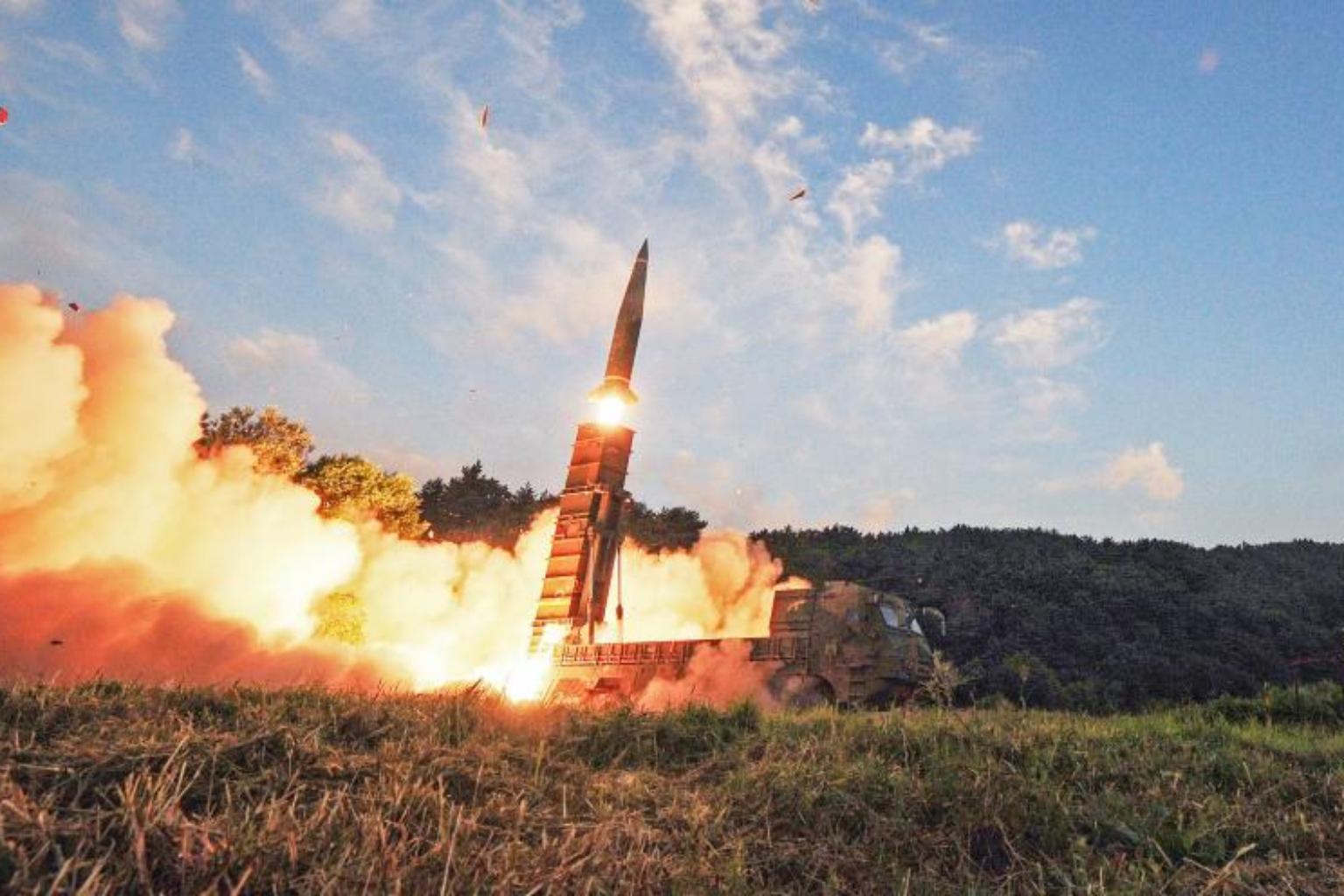How the US could respond to another North Korean missile test
Sign up now: Get ST's newsletters delivered to your inbox

A Hyunmoo-2 missile being launched at an undisclosed location on the east coast of South Korea, on Sept 4, 2017.
PHOTO: EPA
Follow topic:
WASHINGTON (NYTIMES) - South Korea's Prime Minister Lee Nak Yon is saying publicly what US officials will not: In the next few days, intelligence reports predict, North Korea will launch another intercontinental ballistic missile (ICBM).
US Secretary of Defence James Mattis said this week that President Donald Trump had been presented with all military options and would meet threats with a "massive military response" that would be "effective and overwhelming."
Trump's aides will not indicate whether fueling up another ICBM constitutes a threat, saying they want to keep North Korea's leader Kim Jong Un guessing.
The options for a non-military response are becoming clear. On Wednesday (Sept 6), the United States circulated to members of the UN Security Council a draft resolution that would require all countries to cut off the North's oil and all refined petroleum products; it would also allow the Security Council to designate North Korean ships that could be boarded and inspected using "all necessary measures," meaning whatever force was needed.
Ultimately, Secretary of State Rex Tillerson has said, the idea is to force North Korea to the negotiating table, but only after it begins to show a willingness to stop testing and gradually disarm.
But as several of Trump's advisers have noted in recent days, UN resolutions and negotiation strategies are for the medium term. How to handle the launch is the immediate, urgent question.
Here is a look at the president's choices, and their downsides:
A PRE-EMPTIVE STRIKE
Trump told friends that he was proud of the moment in April when he ordered an airstrike on an air base where the Syrian government was believed to have launched chemical weapons attacks. The bombing unfolded during a visit to the United States by President Xi Jinping of China, giving Trump the chance to tell him about it during dinner and to send an unspoken message about what might happen in North Korea if it, like Syria, crossed a "red line."
Technologically, it would not be difficult to destroy North Korea's missiles. US warships off the Korean coast could easily hit the North Korean launch site, which is near the Sea of Japan. They might even provide warning to the North Koreans to evacuate the base.
But unlike the Syrians, the North Koreans know how to strike back - on the South Korean capital, Seoul, or US bases in Japan. Not long ago, President Moon Jae In of South Korea said he had a veto on American attacks on North Korea, and promised "there will be no war" on the Korean Peninsula. (The Americans have a different view, saying that when it comes to defending American territory, no other country has veto rights.)
But destroying one missile would do nothing to the North's many others. And the United States might have a difficult time proving that the missile was truly threatening without proof of where it was aimed.
US officials could argue, though, that Kim offered an unsubtle hint when he was photographed recently by state-run media examining maps of targets in Guam, including a US air base that houses bombers that can reach North Korea.
SHOOTING DOWN OVER THE PACIFIC
Never has there been a bigger moment for American missile defences - or greater reluctance - to use them.
In the vision the Pentagon has sold to Congress for decades, the warhead of an adversary's missile could be tracked and destroyed in midflight or closer to landing, known as the terminal phase. That is the event for which the United States often trains, with decidedly mixed results.
If the North Korean missile's target was Guam, or the waters near it, shooting it down would be an iffy proposition. The first shots would be taken, most likely, by destroyers armed with what are called Standard missiles, the most successful anti-missile system in the US arsenal.
But to make it work, the destroyers would have to be in the right place, former senior officials say. A Thaad missile defence system, like the ones the United States has placed in South Korea, could also be employed.
If the missile were headed toward the continental United States, it could be taken out by one of the anti-missile systems in Alaska and California. In tests, they hit the target about half the time, under perfect conditions.
LET IT HAPPEN
This has been the approach thus far: Track the missile, determine quickly whether it is a threat to a populated area and let it fall into the sea. That is the most cautious response, and Trump could use it to press China and Russia to drop their objections to more UN sanctions.
But it is not cost-free. In each test, the North Koreans get more information to perfect their future launches. And after Trump warned that any threat to the United States would be met with "fire and fury," he is acutely aware that making no active response might make it look as if he had ignored his own red line, exactly what he accused President Barack Obama of doing with Syria.
OTHER OPTIONS
In the cyber age, perhaps the most tempting solution for presidents is to reach for America's most stealthy weapon. That is what Obama did in 2014, when he ordered an acceleration of cyberattacks aimed at preventing launches.
But there is debate over the effectiveness of that operation and little visible evidence that the cyberattacks, if continuing, are working now. Perhaps the United States is waiting for the right moment, but as one former senior cyberoperator said, no target is harder than North Korea.
And the North Koreans know it.

